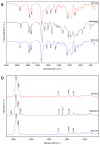A Comparison of Three-Layer and Single-Layer Small Vascular Grafts Manufactured via the Roto-Evaporation Method
- PMID: 38794507
- PMCID: PMC11125268
- DOI: 10.3390/polym16101314
A Comparison of Three-Layer and Single-Layer Small Vascular Grafts Manufactured via the Roto-Evaporation Method
Abstract
This study used the roto-evaporation technique to engineer a 6 mm three-layer polyurethane vascular graft (TVG) that mimics the architecture of human coronary artery native vessels. Two segmented polyurethanes were synthesized using lysine (SPUUK) and ascorbic acid (SPUAA), and the resulting materials were used to create the intima and adventitia layers, respectively. In contrast, the media layer of the TVG was composed of a commercially available polyurethane, Pearlbond 703 EXP. For comparison purposes, single-layer vascular grafts (SVGs) from individual polyurethanes and a polyurethane blend (MVG) were made and tested similarly and evaluated according to the ISO 7198 standard. The TVG exhibited the highest circumferential tensile strength and longitudinal forces compared to single-layer vascular grafts of lower thicknesses made from the same polyurethanes. The TVG also showed higher suture and burst strength values than native vessels. The TVG withstood up to 2087 ± 139 mmHg and exhibited a compliance of 0.15 ± 0.1%/100 mmHg, while SPUUK SVGs showed a compliance of 5.21 ± 1.29%/100 mmHg, akin to coronary arteries but superior to the saphenous vein. An indirect cytocompatibility test using the MDA-MB-231 cell line showed 90 to 100% viability for all polyurethanes, surpassing the minimum 70% threshold needed for biomaterials deemed cytocompatibility. Despite the non-cytotoxic nature of the polyurethane extracts when grown directly on the surface, they displayed poor fibroblast adhesion, except for SPUUK. All vascular grafts showed hemolysis values under the permissible limit of 5% and longer coagulation times.
Keywords: biomedical applications; burst pressure; compliance; mechanical properties; roto-evaporation; vascular graft.
Conflict of interest statement
The authors declare no conflicts of interests.
Figures










Similar articles
-
Mechanical properties of l-lysine based segmented polyurethane vascular grafts and their shape memory potential.Mater Sci Eng C Mater Biol Appl. 2019 Sep;102:887-895. doi: 10.1016/j.msec.2019.04.073. Epub 2019 Apr 24. Mater Sci Eng C Mater Biol Appl. 2019. PMID: 31147060
-
Electrospun vascular grafts with improved compliance matching to native vessels.J Biomed Mater Res B Appl Biomater. 2015 Feb;103(2):313-23. doi: 10.1002/jbm.b.33201. Epub 2014 May 21. J Biomed Mater Res B Appl Biomater. 2015. PMID: 24846218 Free PMC article.
-
Towards compliant small-diameter vascular grafts: Predictive analytical model and experiments.Mater Sci Eng C Mater Biol Appl. 2019 Jul;100:715-723. doi: 10.1016/j.msec.2019.03.023. Epub 2019 Mar 8. Mater Sci Eng C Mater Biol Appl. 2019. PMID: 30948109
-
Small caliber vascular grafts. Part II: Polyurethanes revisited.J Biomater Appl. 1996 Jul;11(1):37-61. doi: 10.1177/088532829601100102. J Biomater Appl. 1996. PMID: 8872599 Review.
-
Considerations in the Development of Small-Diameter Vascular Graft as an Alternative for Bypass and Reconstructive Surgeries: A Review.Cardiovasc Eng Technol. 2020 Oct;11(5):495-521. doi: 10.1007/s13239-020-00482-y. Epub 2020 Aug 18. Cardiovasc Eng Technol. 2020. PMID: 32812139 Review.
Cited by
-
Mechanical Behavior of Polymeric Materials: Recent Studies.Polymers (Basel). 2024 Oct 5;16(19):2821. doi: 10.3390/polym16192821. Polymers (Basel). 2024. PMID: 39408530 Free PMC article.
References
-
- WHO World Health Statistics 2022: Monitoring Health for the SDGs, Sustainable Development Goals. [(accessed on 19 January 2023)]; Available online: https://www.who.int/publications/i/item/9789240051157.
Grants and funding
LinkOut - more resources
Full Text Sources
Miscellaneous

